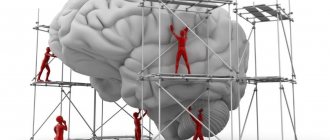Gestalt psychology is a special direction in psychological theory that was created in Germany. The main idea of this direction was that the mental processes of the human body are capable of self-regulation, that is, a person must always be responsible for his actions. Thanks to the main representatives M. Wertheimer, W. Köhler, K. Koffka, a certain methodology was developed that made it possible to holistically approach the study of the psychological aspects of the human body.
What is Gestalt?
Gestalt (from German gestalt - “whole image”) is a certain entity consisting of several parts, but perceived by a person as single and indivisible. For our psyche, the role of a gestalt is most often played by a sequence of actions, having started which we feel the need to complete it.
We need the integrity of images. Although in most cases this need seems irrational, it was formed in the course of evolution. Our brain is more comfortable working with a whole image than with many small details. Thanks to this feature, we immediately recognize familiar faces without looking at the nose and eyebrows, and instantly recognize any household object without trying to analyze its shape.
Gestalt is also a powerful mechanism that allows you to keep unfinished things in your memory (and motivates you to complete them). For example, you can make a list of things you need to buy throughout the day. Coffee, sugar, napkins... Even without resorting to mnemonics and without writing the list in a notebook, you can easily remember a dozen items and keep them in your memory even the next day. But try to remember this list an hour after going to the store, and you will find that you have forgotten half of the items.
Gestalt helps us remember important things and forget them almost immediately when the job is done. And each of us constantly uses this feature of the psyche, without thinking at all. But sometimes it fails, and some irrelevant things turn into unclosed gestalts. Sometimes these are really unpleasant and painful situations, and sometimes they are completely ordinary things, next to which we simply forgot to mentally check the “Done!” box.
What problems does this type of psychology solve?
Gestalt psychology allows us to be aware of our experiences and choose the right solution for them. But for this, a person needs to abstract from his past experience, clear his consciousness of the standards of cultural and personal traditions.
The founders of this direction in psychology identified 5 main stages that allow us to understand and solve the emerging problem:
- The emergence of a problematic situation - at this stage, a feeling of tension appears, which stimulates creative forces.
- Analysis of the problem and its awareness is the perception of a holistic image of the problem situation.
- Solving the problem - thought processes take place unconsciously.
- Alternative methods for solving the problem (insights)
- Execution.
The concept of insight in Gestalt psychology has become fundamental. It explained all forms of mental activity, including productive ones. The individual and his environment were considered only as a single whole.
Thanks to many works, Gestalt psychology has become widely used in the field of psychotherapeutic practice. The most widespread direction in modern psychotherapy, Gestalt therapy, was built on its principles. Without a doubt, we can say that Gestalt psychology has made a huge contribution to the development of world science.
How is Gestalt formed?
Usually a gestalt is formed on the basis of a disturbing memory. For example, during a quarrel you can be rude to a loved one, and then think about this situation and lament. It also happens the other way around. For example, having quarreled with an unpleasant person, you did not find the appropriate words to upset him. After that, you can scroll through this situation in your head many times , choosing the right words. Even though you understand that this is a pointless activity, you still continue to think about it.
The most unpleasant thing is that gestalt is almost always formed precisely on the basis of negative memories. Our brain perceives all pleasant events as completed and sends them to the “archive”. But he considers it necessary to think about the unpleasant ones. Therefore, even if we try to forget about an unpleasant situation, a negative image obsessively pops up in our memory, because our psyche needs to bring it to its logical conclusion. But it turns out the other way around - the longer we think about the event, the more convinced we become that we should have acted differently. Therefore, the gestalt not only does not go away, but is also consolidated.
Sometimes such a gestalt can be closed on its own. For example, if there was a repeated argument with the offender, and this time you “performed” absolutely successfully, putting the enemy in his place. A completely opposite solution is also possible: you made peace, found out the causes of the conflict, discussed everything and came to some kind of consensus. But in most cases, it is almost impossible to close the gestalt without the help of a psychotherapist.
Reasons for the appearance of gestalts
To better understand what gestalt is, scientists conducted studies with representatives of different nationalities. They discovered an interesting pattern: people living in conditions of a primitive communal system are not susceptible to the formation of open gestalts. Moreover, even in a civilized society, the higher the level of education and social status of a particular person, the higher the probability of the formation of a gestalt in a particular person.
Why is this happening? The reason is simple: a gestalt is formed if a person’s achievements in life are important. An educated person often thinks about his past, evaluates the morality of his own actions, rethinks his choices and analyzes his mistakes. A representative of a tribe, unlike him, lives for today. He works, has fun, builds a house and starts a family, based on current needs. And he has absolutely no time to think about his own mistakes.
What does Gestalt psychology talk about?
This branch of psychology considers the existence of two “human worlds”:
- Physical, which does not affect personal experiences
- The world of sensations reflects the influence of many external factors on our consciousness.
Gestalt psychology did not accept the principles of dividing consciousness into its component parts. Representatives of this direction noted that perception is not formed only through sensations, and the properties of a figure cannot be described by characterizing each part separately. The human consciousness collects each piece of the mosaic and forms a single whole , forming a gestalt. What it is?
Gestalt (form, image) is the structural formation of particles into a single whole. This is the basic concept of Gestalt psychology.
People must be aware of their needs, emotions and feelings, communication preferences and perceptions of the outside world. Gestalt psychology does not focus on quickly resolving minor problems. At its core there is something more. Working with a specialist in this field will allow you to completely reconsider your life position and completely immerse yourself in the real world.
Basic principles of Gestaltism
In order to achieve a holistic perception and orderliness of its structure, it is necessary to resort to the basic principles of Gestalt:
- The principle of proximity - those images that are nearby are perceived together.
- The principle of similarity is that several forms that have a common size, shape, and color are perceived together.
- The principle of closure - consciousness strives to complete the missing parts of the figure, which subsequently takes on its full form.
- The principle of integrity - the world is perceived in a simplified and holistic form.
- The principle of contiguity is characterized by the proximity of stimuli in time and space.
- Common area - the listed concepts form our complete perception of reality, taking into account past life experiences.
We recommend that you read: Definition of empathy in psychology: what it is and what it affects in life
What is Gestalt therapy?
If the gestalt is not closed, a person constantly attracts a problem that has long become irrelevant into his life. He himself does not realize that for several months or even years he has been carrying this meaningless emotional burden on his own shoulders. Gestalt therapy is an effective way to get rid of such destructive memories from the distant past that prevent a person from living a full life in the present.
A Gestalt therapy specialist knows how to find psychological “clamps” that keep a person in constant tension. This is quite a responsible job, since an unclosed gestalt, unlike many other psychological problems, cannot be cured with pills. There is only one way to get rid of it: find and neutralize it. This is exactly what a Gestalt therapist does.
One thing to keep in mind is that this form of therapy is not all that pleasant. We have to remember many traumatic events from the past, and this is usually quite painful. But this approach helps to get rid of the psychological block, throwing off a useless burden from your shoulders. When the gestalt is closed, memories no longer torment a person, even if he accidentally remembers those unpleasant events.
Research by Wolfgang Keller
Wolfgang Keller - German and American psychologist, one of the founders of Gestalt psychology, dealt with the problems of general, comparative, experimental psychology. Introduced the principle of isomorphism (equality of forms in the physical, physiological and phenomenal fields).
V. Keller studied problem solving by apes. Experiments with chimpanzees allowed him to understand that the task assigned to an animal is solved either by trial and error (blindly searching for the right solution) or through sudden awareness.
Köhler's experiments proved that the thought process follows the second path, i.e. there is an instant grasp of the situation and the correct solution to the task.
Köhler came to the conclusion that objects and objects that are in the field of perception and are in no way connected with each other, in the process of solving a problem, begin to unite into a single structure, the vision of which helps to solve the problem. This process happens instantly. V. Koehler called this phenomenon insight.
Insight is inner illumination, sudden understanding and finding a solution.
Explaining the phenomenon of insight, he believed that the moment phenomena enter another situation, they acquire a new function. The combination of objects in new combinations associated with their new functions leads to the formation of a new gestalt, the awareness of which is the essence of thinking.
Köhler conducted a series of experiments with children to study thinking in order to prove that humans solve certain problems in a similar way. He offered the children a problem situation similar to the one put before the monkeys (for example, getting a typewriter that was located on a cabinet). To get the typewriter, the children included various objects in the gestalt with the closet (a ladder or other objects: drawers, a table with a chair).
How can you use gestalts?
In most cases, we try to get rid of gestalts, but they may well be beneficial. Let's look at some of the most illustrative examples:
1. Task lists
. For many people, they add motivation and energy, helping them work more efficiently. If you also keep lists of tasks and are happy to mark those completed, then you are using the power of Gestalt for your benefit.
2. Memory of unfinished business
. We involuntarily use gestalt when we hold something important in memory (for example, a promise to call our parents at 19:00). And we remember this all day, not because we have a good memory, but because we deliberately left the gestalt open.
3. 15 minute rule
. You probably know this rule, which helps you do complex and tedious work. For example, you are faced with a routine task that will take 2 hours to complete. According to the “15 minutes” rule, you need to start right now, but after 15 minutes you can switch to other things. Quite often, gestalt comes into play, helping to complete boring work in one go.
4. Coupons with stickers
. We are talking about booklets in which you need to paste stickers in order to receive some kind of bonus at the end. The secret is that several stickers have already been pasted for you, and this forms a gestalt - the desire to add all the missing stickers, even if the bonus is cheap. You've probably been given such coupons by promoters or hypermarket cashiers.
The above example with stickers looks more harmful than useful, since marketers use the peculiarity of our psyche in their own interests. Hint: to close such a gestalt, just carefully crumple up the coupon and throw it in the trash with a sense of accomplishment.
Still, there are benefits to be gained from this format. For example, you can print out a similar coupon and stickers for it for yourself. Next, while completing certain (not very pleasant) tasks, you can paste in stickers, and when the coupon is full, you can buy yourself a reward.
This approach also works great with children. Does your child want a new smartphone? Print him a small poster with a picture of his goal and space for stickers. After that, give him another sticker for each achievement that you consider important.










